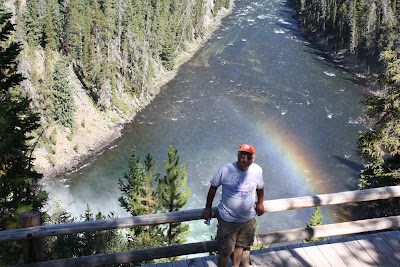 |
| Seed corn with "Bull rows" |
Bill grew up in the Snake River valley and we took some time to drive around and see the vast areas of farmland and on Monday went up to McCall ID about 90 miles north and in the high country. I think we discussed the production of seed potatoes, and I also saw hybrid seed corn being grown. The idea is that there is a hybrid synergy when two different breeds are "mated". This is done by having 3 or 4 rows of the corn that will become seed, and one row of the other variety that indiscriminately distributes it's pollen in a mid western fit of unsafe corn sex!!.
The hybrid synergy only lasts for the first season so farmers who use the corn have to buy new seed every year!. Very cunning and a great way to keep the price up I suspect. I am not sure if the "Bull row" is removed prior to harvesting but I think it is highly likely.
That is probably more than you wanted to know about growing corn and corn sex in general!Pretty much all of the NW part of the US drains into the Columbia River that drains in to the Pacific just west of Portland Oregon. Some of it's tributaries are the the Boise, Salmon, Payette and Snake Rivers. I saw all of them and in Idaho and Montana.
 | ||
| Confluence of the Boise and Snake Rivers close to the Oregon State Line. |
I guess I got a little off track with that, but I have been concerned that the blog was becoming a travelblog and was lacking commentary. Maybe this is back!
Bill and I also headed up the Payette River valley on Monday towards Cascade and McCall ID. Boise is about 2800 ft elevation and McCall is over 5000 ft with a distance of approx 90 miles (may have said that already)
 | |
| Payette River near Smiths Ferry. |
 |
| My friend Bill by the Payette River |
 |
| Wonder what sort of clients they are trying to attract!! |
 |
| They should have signs like this one in more states! |
Again it is a beautiful and twisty road with occasional flat arears and small lakes on the river and then fast running water just around the curve.
We reached Cascade ID and had a late breakfast, but passed the airport just as we came in to town and there was much evidence of firefighting teams and both fixed wing and rotary aircraft used for fire fighting.
McCall is a small town on a lake that is a very popular weekend getaway. It looks prosperous and I suspect has a significant retiree population as well. It sits on the south end of a lake and there are some very beautiful homes along the lakeside.
We headed over the watershed in to the Weiser River valley and came back down to Boise that way. The scenery was not as interesting although we did see one place that looked like it had an airport control tower and a forbidding entrance and signs that were not conducive to a friendly welcame. We kept going!
We made a brief visit to Nyssa Oregon, mostly so that we had been to Oregon. There was an old sugar beet processing plant there and not too much else. It was a truly depressing place as any industry there was is gone and there is almost nothing left. That appears to be true of many small towns in the west and mid west where smaller family farms once ruled but the mega farms have taken over and reduced jobs and distributed wealth. I would say that in somewhere like Mud Lake or Nyssa you were either fairly wealthy and a significant employer or poor and a worker, very likely Hispanic judging by the stores and general appearance.
We headed back to Boise and I parted company with Bill as I had a very early flight the next day and stayed by the airport.
This was an interesting and very enjoyable trip, but the first part was very different from my NZ and Australia travels as I was in a rental car and did not get a chance to meet and talk with people as I had become accustomed to on the Antipodean trip.
I am home for a while with a possible trip to Guatemala in November to learn some Spanish. I will recrank the blog at that point.
Thanks for reading and commenting on my oddesy ,











































